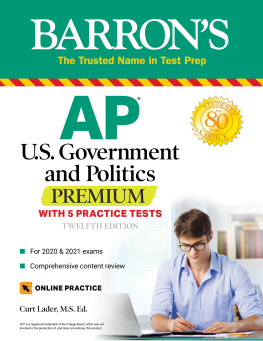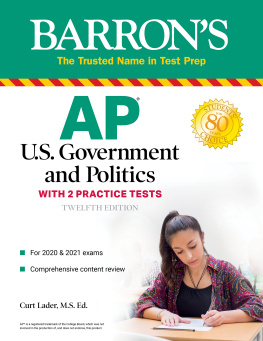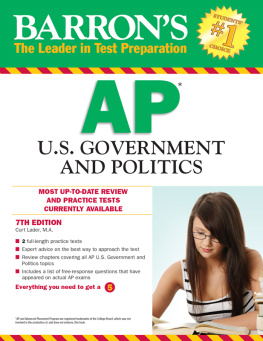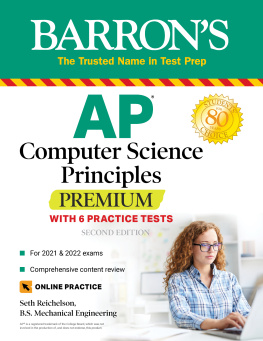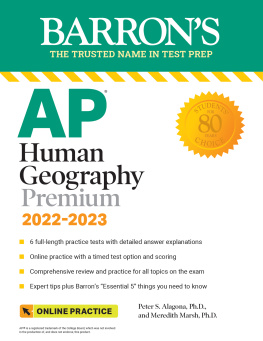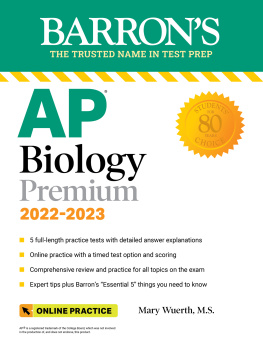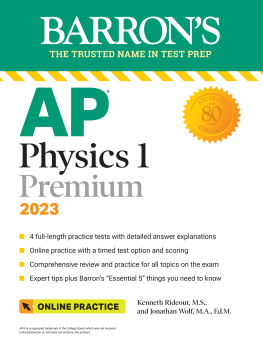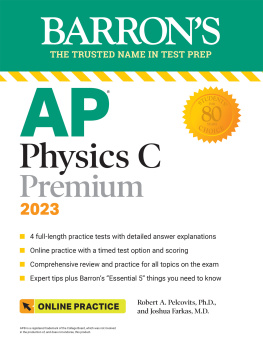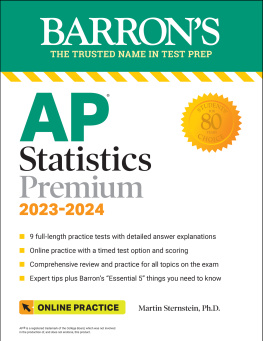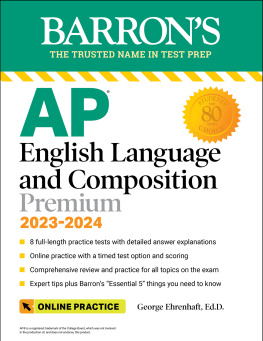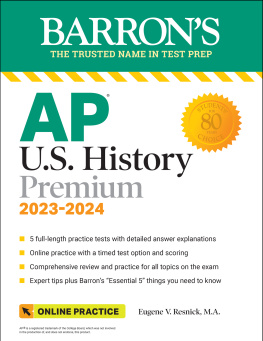Table of Contents
Guide
Page List

Copyright 2022, 2020, 2018, 2017, 2016, 2014, 2012, 2010, 2008, 2006, 2002, 1998, 1995 by Kaplan North America, LLC, d/b/a Barrons Educational Series.
All rights reserved under International and Pan-American Copyright Conventions. By payment of the required fees, you have been granted the non-exclusive, non-transferable right to access and read the text of this eBook on screen. No part of this text may be reproduced, transmitted, downloaded, decompiled, reverse engineered, or stored in or introduced into any information storage and retrieval system, in any form or by any means, whether electronic or mechanical, now known or hereinafter invented, without the express written permission of the publisher.
Published by Kaplan North America, LLC, d/b/a Barrons Educational Series
1515 West Cypress Creek Road
Fort Lauderdale, FL 33309
www.barronseduc.com
ISBN: 978-1-5062-7837-7
10 9 8 7 6 5 4 3 2

About the Author
Curt Lader taught social studies for 36 years and AP U.S. Government and Politics for 13 of those years at Northport High School on Long Island before retiring. He holds a masters degree in education from Queens College and a professional diploma in Educational Administration from St. Johns University.
In addition to teaching AP U.S. Government and Politics, Mr. Lader also taught American History through Constitutional Law, a course which emphasized much of the content that is part of the AP U.S. Government and Politics course. Students frequently participated in Supreme Court moot court cases, the same activity that is recommended to AP students. Related to his teaching, Mr. Lader was the adviser to the Northport High School Moot Court Law Club. Mr. Lader was also the adviser to Northport High Schools award-winning student newspaper and was president of scholastic journalism organizations on the local, state, and federal levels. In that role, he was asked to write a friend of the court brief in the Hazelwood v. Kuhlmeier (1988) Supreme Court case, a case related to one of the required Supreme Court cases found in the AP U.S. Government and Politics curriculum.
The Northport-East Northport School District recognized Mr. Laders many accomplishments by giving him its Professional Achievement Award.
Besides classroom teaching, Mr. Lader was also a conference speaker at the Youth, Law and Citizenship conferences, which also increased his working knowledge of the content found in the AP U.S. Government and Politics curriculum. He was also a lecturer at LIU Post teaching an enrichment course for adults, Inside Politics Today.
Table of Contents
This book offers a comprehensive review of the Enduring Understandings, Key Concepts, Learning Objectives, and Essential Knowledge taught in the AP U.S. Government and Politics course, with many historical examples cited for illustration. Each element of this book is designed to prepare you for the exam.
Diagnostic Test
First, take the Diagnostic Test to gain an understanding of your strengths and weaknesses. It is a complete test with answer explanations and includes four free-response questions and scoring rubrics for those questions.
Review and Practice
This book includes five content review chapters that align with the five units of the AP course curriculum. In addition, each chapter contains:
An overview of the Enduring Understandings and Key Concepts
In-depth review of key terms, Big Ideas, required documents, and required Supreme Court cases
Practice multiple-choice questions that highlight stimulus material, such as graphs and tables, political cartoons, maps, and excerpts from text-based sources. All multiple-choice and free-response questions include answer explanations and sample scoring rubrics.
A Glossary of Key Terms and an Appendix that includes the required documents and Supreme Court cases
Practice Tests
The final section of the book offers the opportunity to take two full-length practice tests that include all question types found on the actual exam. A comprehensive answer explanation is provided for each multiple-choice question, and a model answer and scoring rubric are provided for all free-response questions and the argument essay.
Online Practice
In addition to the diagnostic test and two practice tests within this book, there are also two full-length online practice exams. You may take these exams in practice (untimed) mode or in timed mode. All questions include answer explanations.
For Students
Because the 20212022 school year is the fourth year of the newly redesigned course and test, you have the opportunity to prepare for the exam by concentrating on the areas that the College Board has identified as essential knowledge. This review book highlights the key concepts in each chapter and explains them by giving content examples. How you use the book depends on how your school offers the course. Nevertheless, by answering the review questions at the end of each chapter and by taking the practice tests, you will have an indication of how well you will do on the actual exam.
For Teachers
Suggest to your students that they use this book along with their textbook. If you develop your own assignments and tests around the Enduring Understandings, Key Concepts, Learning Objectives, and Essential Knowledge found in the College Boards 20182019 AP U.S. Government Curriculum Framework, this book should offer your students the opportunity to use the material for review.
As you review the content in this book and work toward earning that on your AP U.S. Government and Politics Exam, here are five essentials that you MUST know above everything else:
| Know the principles of the United States Constitution. Understand the elitist and pluralist theories of government, separation of powers, checks and balances, and federalism. Make sure you understand the relationship between the federal and state governments as well as the interrelationship among the branches of government and bureaucracies. Most importantly, know how the Constitution is a defining document that illustrates how we as a country wanted a government with limited powers and the rule of law. |
| Identify the concept of liberty and order. Understand how civil liberties and civil rights have played an essential role in our democracy in achieving liberty and order. Know the differences between civil rights and civil liberties. There are required Supreme Court cases that apply to these topics. Explore the concept of selective incorporation of the Fourteenth Amendment to the U.S. Constitution. |
| Explore the importance of the American political culture. Explain how popular sovereignty is an essential aspect of our representative democracy. Compare the differences and similarities of the political parties and how they conduct elections. Analyze how political socialization determines political beliefs. Understand the nature of political participation. |
| |


